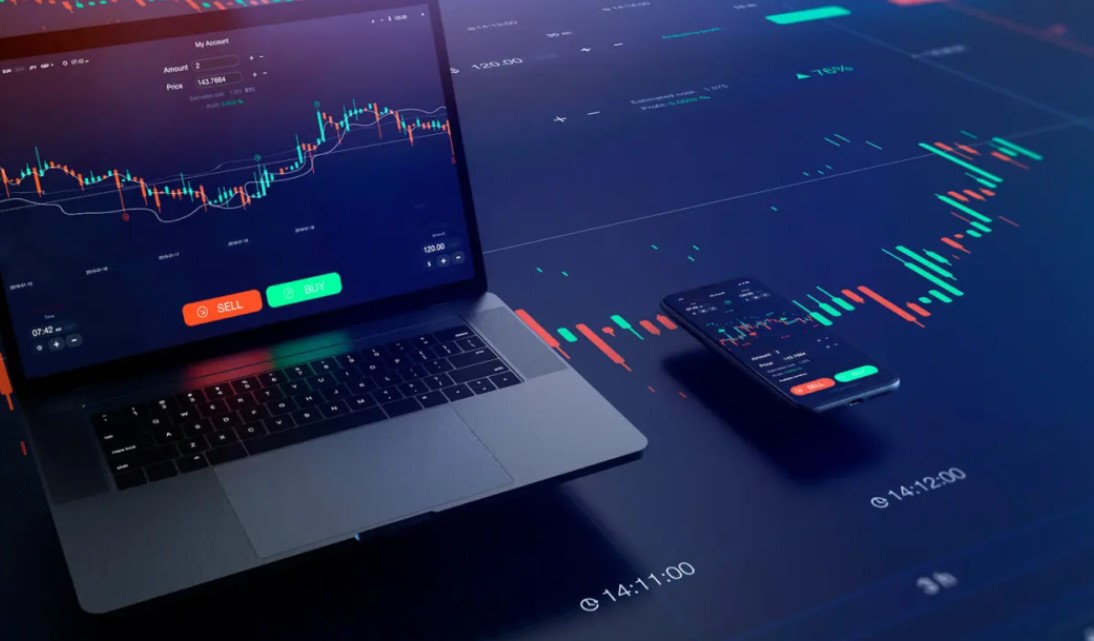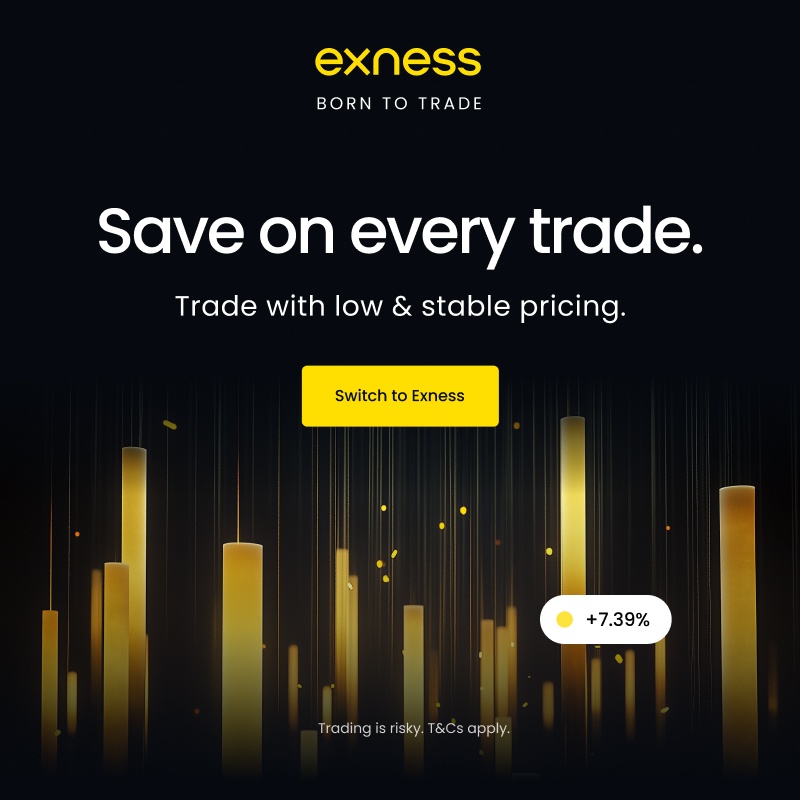
9 minute read
How to Start Forex Trading in South Africa: A Comprehensive Guide
from Exness
by Exness_Blog
Forex trading, or foreign exchange trading, has gained immense popularity in South Africa as a lucrative opportunity for individuals seeking financial independence. With its potential for high returns, forex trading attracts both seasoned investors and beginners. However, success in this dynamic market requires knowledge, discipline, and a strategic approach. If you’re based in South Africa and wondering how to start forex trading, this comprehensive guide will walk you through every step, from understanding the basics to executing your first trade.
Top 4 Best Forex Brokers in South Africa
1️⃣ Exness: Open An Account or Visit Brokers 🏆
2️⃣ XM: Open An Account or Visit Brokers 💥
3️⃣ JustMarkets: Open An Account or Visit Brokers ✅
4️⃣ Quotex: Open An Account or Visit Brokers 🌐
What is Forex Trading?
Forex trading involves buying and selling currencies on the global foreign exchange market to profit from fluctuations in exchange rates. For example, you might buy the South African Rand (ZAR) against the US Dollar (USD) if you believe the ZAR will strengthen. The forex market operates 24 hours a day, five days a week, making it highly accessible for South Africans.
The forex market is the largest financial market in the world, with a daily trading volume exceeding $6 trillion. Its accessibility and flexibility make it an appealing option for South Africans looking to diversify their income streams. However, forex trading carries risks, and understanding the market is crucial before diving in.
Why Start Forex Trading in South Africa?
South Africa’s growing economy and increasing internet access have made forex trading more accessible than ever. Here are some reasons why forex trading is appealing to South Africans:
· Low Entry Barriers: You can start trading with as little as $10, depending on the broker.
· Flexible Hours: The 24/5 market allows you to trade at your convenience, even after regular work hours.
· High Liquidity: The forex market’s massive volume ensures you can enter and exit trades quickly.
· Potential for Profit: With proper strategies, traders can profit from both rising and falling markets.
· Regulated Environment: South Africa’s Financial Sector Conduct Authority (FSCA) regulates forex brokers, ensuring a safer trading environment.
However, forex trading is not a get-rich-quick scheme. It requires education, practice, and risk management to succeed.
Step-by-Step Guide to Start Forex Trading in South Africa
1. Educate Yourself About Forex Trading
Before you start trading, invest time in learning the basics of forex. Key concepts to understand include:
· Currency Pairs: Forex trading involves trading currency pairs, such as USD/ZAR (US Dollar/South African Rand) or EUR/USD (Euro/US Dollar). Pairs are categorized into majors, minors, and exotics.
· Pips and Lots: A pip is the smallest price movement in a currency pair, while a lot represents the trade size.
· Leverage and Margin: Leverage allows you to control larger positions with smaller capital, but it also increases risk. Margin is the amount required to open a leveraged position.
· Technical and Fundamental Analysis: Technical analysis involves studying charts and indicators, while fundamental analysis focuses on economic events like interest rate changes or GDP reports.
Resources for Learning:
· Online courses on platforms like Udemy or Coursera.
· Free resources from reputable brokers like XM, FBS, or AvaTrade.
· Forex trading books like Currency Trading for Dummies by Brian Dolan.
Action Tip: Spend at least 1–2 months learning the basics before risking real money. Use free resources tailored to South African traders to understand local market nuances.
2. Choose a Reputable FSCA-Regulated Broker
Selecting a reliable forex broker is critical for success. In South Africa, ensure the broker is regulated by the Financial Sector Conduct Authority (FSCA) to protect your funds. Here are factors to consider when choosing a broker:
· Regulation: Verify the broker’s FSCA license number.
· Trading Platform: Popular platforms like MetaTrader 4 (MT4) or MetaTrader 5 (MT5) are user-friendly and widely used.
· Fees and Spreads: Look for competitive spreads and low commissions. Avoid brokers with hidden fees.
· Deposit and Withdrawal Methods: Ensure the broker supports local payment methods like bank transfers, EFT, or mobile payments (e.g., M-Pesa).
· Customer Support: Choose a broker with responsive support, ideally offering 24/7 assistance.
Popular FSCA-Regulated Brokers in South Africa:
· Exness: Provides fast withdrawals and competitive spreads.
· XM: Known for low spreads and excellent customer support.
· AvaTrade: Offers a wide range of trading instruments and educational resources.
· FBS: Ideal for beginners with low minimum deposits.

💥 Trade with Exness now: Open An Account or Visit Brokers 🏆
Action Tip: Research brokers on the FSCA website (www.fsca.co.za) (www.fsca.co.za) to confirm their regulation status. Open a demo account to test the platform before committing funds.
3. Open a Forex Trading Account
Once you’ve chosen a broker, follow these steps to open a trading account:
· Visit the Broker’s Website: Go to the official website of your chosen broker and click “Open Account” or “Register.”
· Complete the Application: Provide personal details like your name, email, and phone number.
· Verify Your Identity: Submit proof of identity (e.g., ID card or passport) and proof of residence (e.g., utility bill) to comply with KYC (Know Your Customer) regulations.
· Choose an Account Type: Brokers offer various account types (e.g., Standard, Micro, or ECN). For beginners, a Micro or Standard account is ideal due to lower risk.
· Deposit Funds: Most brokers accept deposits via bank transfer, credit/debit cards, or local payment methods. The minimum deposit can range from $5 to $100.
Action Tip: Start with a demo account to practice trading without risking real money. Most brokers offer demo accounts with virtual funds.
4. Develop a Trading Plan
A trading plan is your roadmap to success in forex trading. It outlines your goals, risk tolerance, and trading strategy. Key components of a trading plan include:
· Trading Goals: Define realistic profit targets (e.g., 5–10% monthly returns) and timeframes.
· Risk Management: Never risk more than 1–2% of your account balance on a single trade. Use stop-loss orders to limit losses.
· Trading Strategy: Choose a strategy that suits your style, such as day trading, swing trading, or scalping. Test your strategy on a demo account.
· Trading Journal: Record every trade to track performance and identify areas for improvement.
Popular Trading Strategies:
· Trend Following: Trade in the direction of the market trend using moving averages or trendlines.
· Breakout Trading: Enter trades when the price breaks through key support or resistance levels.
· Range Trading: Trade within a defined price range using oscillators like RSI or Stochastic.
Action Tip: Backtest your trading strategy on historical data to ensure its effectiveness before using real money.
5. Practice with a Demo Account
A demo account allows you to trade with virtual money in real market conditions. It’s an essential step for beginners to:
· Familiarize yourself with the trading platform.
· Test your trading strategy without financial risk.
· Build confidence in executing trades.
Most brokers offer unlimited demo accounts with virtual funds ranging from $10,000 to $100,000. Spend at least 2–3 months practicing on a demo account until you consistently achieve profitable results.
Action Tip: Treat your demo account like a real account to develop discipline and avoid reckless trading habits.
6. Start Trading with Real Money
Once you’re confident in your skills, transition to a live trading account. Start small to minimize risk:
· Deposit a Small Amount: Begin with an amount you can afford to lose, such as $50–$100.
· Use Low Leverage: High leverage (e.g., 1:500) can amplify losses. Start with 1:10 or 1:50 leverage.
· Stick to Your Plan: Follow your trading strategy and risk management rules religiously.
· Monitor Economic Events: Stay updated on global economic news, as events like US Federal Reserve announcements or South African Reserve Bank decisions can impact currency pairs.
Action Tip: Use a trading app like MT4 or MT5 to monitor trades on the go. Many brokers offer mobile apps compatible with iOS and Android.
7. Manage Risks Effectively
Risk management is the cornerstone of successful forex trading. Here are key practices to protect your capital:
· Set Stop-Loss Orders: Automatically close trades at a predetermined loss level to avoid large losses.
· Use Proper Position Sizing: Calculate your trade size based on your account balance and risk tolerance.
· Avoid Overtrading: Limit the number of trades to maintain focus and avoid emotional decisions.
· Diversify Trades: Avoid putting all your capital into a single currency pair.
Action Tip: Use a risk-reward ratio of at least 1:2 (e.g., risk $10 to make $20) to ensure your winners outweigh your losers.
8. Stay Informed and Keep Learning
The forex market is constantly evolving, so continuous learning is essential. Stay updated by:
· Following economic calendars to track events like interest rate decisions or inflation reports.
· Reading forex news on platforms like Bloomberg, Reuters, or DailyFX.
· Joining South African forex trading communities on platforms like X or local forums to exchange ideas.
· Attending webinars or workshops hosted by brokers or trading educators.
Action Tip: Subscribe to a reputable forex newsletter or follow FSCA-regulated brokers on social media for market updates.
Common Mistakes to Avoid in Forex Trading
· Trading Without a Plan: Entering trades without a strategy leads to emotional decisions and losses.
· Overleveraging: High leverage can wipe out your account if the market moves against you.
· Ignoring Risk Management: Failing to use stop-loss orders or risking too much per trade is a recipe for disaster.
· Chasing Losses: Trying to recover losses by taking impulsive trades often leads to bigger losses.
· Not Practicing Enough: Jumping into live trading without sufficient demo practice is risky.
Action Tip: Review your trades weekly to identify mistakes and refine your strategy.
Legal and Tax Considerations in South Africa
Forex trading is legal in South Africa, but you must comply with regulations:
· FSCA Compliance: Only trade with FSCA-regulated brokers to ensure fund safety.
· Tax Obligations: Forex trading profits are subject to income tax in South Africa. Consult a tax professional to understand your obligations.
· Foreign Exchange Allowances: South Africans are subject to a Single Discretionary Allowance of ZAR 1 million per year for offshore investments, including forex trading. Check with your broker for compliance.
Action Tip: Keep detailed records of your trades for tax purposes and consult a tax advisor to ensure compliance with SARS (South African Revenue Service).
Conclusion: Your Journey to Forex Trading Success
Starting forex trading in South Africa is an exciting opportunity to build wealth, but it requires dedication, education, and discipline. By following the steps outlined in this guide—educating yourself, choosing a regulated broker, practicing with a demo account, and managing risks—you can lay a strong foundation for success. Avoid common pitfalls, stay informed, and continuously refine your skills to navigate the dynamic forex market.
Ready to take the first step? Open a demo account with an FSCA-regulated broker today and start practicing. With patience and persistence, you can unlock the potential of forex trading in South Africa.
💥 Note: To enjoy the benefits of the partner code, such as trading fee rebates, you need to register with Exness through this link: Open An Account or Visit Brokers 🏆
Read more:




